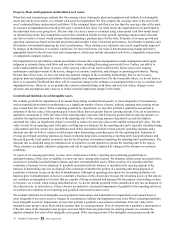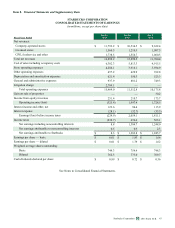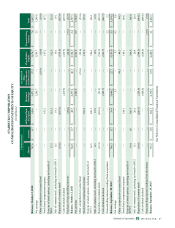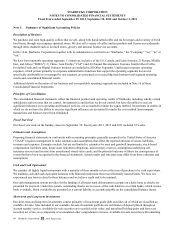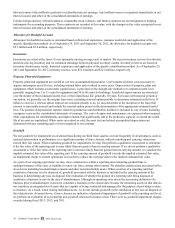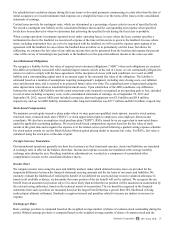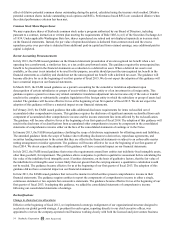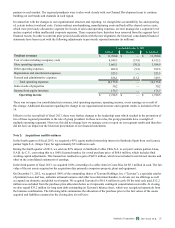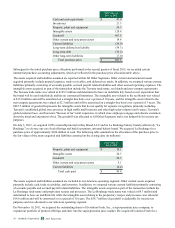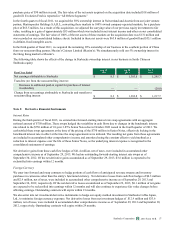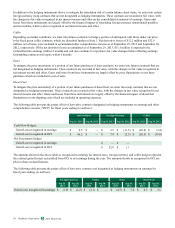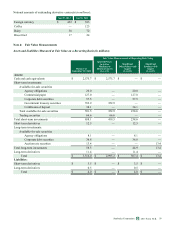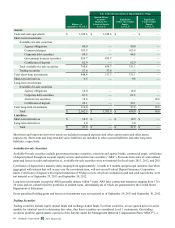Starbucks 2013 Annual Report Download - page 58
Download and view the complete annual report
Please find page 58 of the 2013 Starbucks annual report below. You can navigate through the pages in the report by either clicking on the pages listed below, or by using the keyword search tool below to find specific information within the annual report.
50
forward contract (the ineffective portion) is reclassified into net earnings. Any ineffectiveness is recognized immediately in net
interest income and other on the consolidated statements of earnings.
Certain foreign currency forward contracts, commodity swap contracts, and futures contracts are not designated as hedging
instruments for accounting purposes. These contracts are recorded at fair value, with the changes in fair value recognized in net
interest income and other on the consolidated statements of earnings.
Allowance for Doubtful Accounts
Allowance for doubtful accounts is calculated based on historical experience, customer credit risk and application of the
specific identification method. As of September 29, 2013 and September 30, 2012, the allowance for doubtful accounts was
$5.7 million and $5.6 million, respectively.
Inventories
Inventories are stated at the lower of cost (primarily moving average cost) or market. We record inventory reserves for obsolete
and slow-moving inventory and for estimated shrinkage between physical inventory counts. Inventory reserves are based on
inventory obsolescence trends, historical experience and application of the specific identification method. As of September 29,
2013 and September 30, 2012, inventory reserves were $52.0 million and $22.6 million, respectively.
Property, Plant and Equipment
Property, plant and equipment are carried at cost less accumulated depreciation. Cost includes all direct costs necessary to
acquire and prepare assets for use, including internal labor and overhead in some cases. Depreciation of property, plant and
equipment, which includes assets under capital leases, is provided on the straight-line method over estimated useful lives,
generally ranging from 2 to 15 years for equipment and 30 to 40 years for buildings. Leasehold improvements are amortized
over the shorter of their estimated useful lives or the related lease life, generally 10 years. For leases with renewal periods at
our option, we generally use the original lease term, excluding renewal option periods, to determine estimated useful lives. If
failure to exercise a renewal option imposes an economic penalty to us, we may determine at the inception of the lease that
renewal is reasonably assured and include the renewal option period in the determination of the appropriate estimated useful
lives. The portion of depreciation expense related to production and distribution facilities is included in cost of sales including
occupancy costs on the consolidated statements of earnings. The costs of repairs and maintenance are expensed when incurred,
while expenditures for refurbishments and improvements that significantly add to the productive capacity or extend the useful
life of an asset are capitalized. When assets are retired or sold, the asset cost and related accumulated depreciation are
eliminated with any remaining gain or loss recognized in net earnings.
Goodwill
We test goodwill for impairment on an annual basis during our third fiscal quarter, or more frequently if circumstances, such as
material deterioration in performance or a significant number of store closures, indicate reporting unit carrying values may
exceed their fair values. When evaluating goodwill for impairment, we may first perform a qualitative assessment to determine
if the fair value of the reporting unit is more likely than not greater than its carrying amount. If we do not perform a qualitative
assessment or if the fair value of the reporting unit is not more likely than not greater than its carrying amount, we calculate the
implied estimated fair value of the reporting unit. If the carrying amount of goodwill exceeds the implied estimated fair value,
an impairment charge to current operations is recorded to reduce the carrying value to the implied estimated fair value.
As a part of our ongoing operations, we may close certain stores within a reporting unit containing goodwill due to
underperformance of the store or inability to renew our lease, among other reasons. We abandon certain assets associated with a
closed store including leasehold improvements and other non-transferable assets. When a portion of a reporting unit that
constitutes a business is to be disposed of, goodwill associated with the business is included in the carrying amount of the
business in determining any loss on disposal. Our evaluation of whether the portion of a reporting unit being disposed of
constitutes a business occurs on the date of abandonment. Although an operating store meets the accounting definition of a
business prior to abandonment, it does not constitute a business on the closure date because the remaining assets on that date do
not constitute an integrated set of assets that are capable of being conducted and managed for the purpose of providing a return
to investors. As a result, when closing individual stores, we do not include goodwill in the calculation of any loss on disposal of
the related assets. As noted above, if store closures are indicative of potential impairment of goodwill at the reporting unit level,
we perform an evaluation of our reporting unit goodwill when such closures occur. There were no goodwill impairment charges
recorded during fiscal 2013, 2012, and 2011.
2013 10-K
Starbucks Corporation Form


